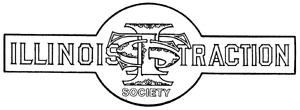
The Plat
| System
Maps |
||||
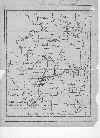 1908 |
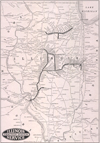 1915 |
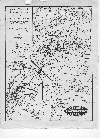 1930 |
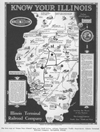 1950 |
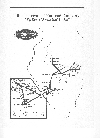 1974 |
Click on one of the above maps to see a full-size image.
By Dale Jenkins
“The Traction”…..”The Interurban”…..”The Terminal”…..names that would readily identify one of the finest railroads to serve Illinois as well as the nation. At one time, it was a 550 mile electric interurban empire that introduced many innovations for the traveler, but yet in years to pass, it became a dieselized freight railroad bound for the annals of railroad history.
The Illinois Traction System was the legacy of founder William B. McKinley, who was involved in the early development of city utilities and later became a U. S. Senator. In 1901 Mr. McKinley began the construction of his empire with the development of the Danville Paxton & Northern. The purpose of this line was to bring coal to his utility power plant in Danville and transport coal miners to the coal fields south of Danville. With a vision, Mr. McKinley began his westward expansion, linking the major cities of Champaign, Decatur, Bloomington, Peoria, Springfield, Staunton and the major commerce center of St. Louis, Missouri. The crowning achievement would be the construction of the magnificent McKinley Bridge over the Mississippi River to enter the Gateway City to the West in 1910.
The Illinois Traction would be the first electric railway to offer sleeping car service. Simultaneously, parlor car service would be introduced and the most modern comfort in passenger service was a hallmark of the system. Freight service would evolve from express traffic to the need for homemade freight motors and belt lines around the major cities. The development of bulk freight was nurtured by the building of on-line industries and the expansion of a rolling stock fleet to rival that of competing steam lines.
In 1923, the Illinois Traction System would evolve into a subsidiary of the Illinois Power & Light Company. This would eventually lead to the additional system development with the acquisition of three steam railroads in the “triangle” of East St. Louis, Edwardsville and the industrial mecca of Alton, Illinois. The Steam Lines would even boast operation of a unique “railbus” between Alton and Grafton, Illinois. The combination of the electric and steam lines would expand the development of freight traffic by direct connection of the Peoria and St. Louis gateways, and serve as the foundation for the survival of the railroad during the Great Depression right up till the time of its demise in 1981. Simultaneously, the acquisition of the high speed suburban service of the St. Louis & Alton , which served the namesake towns, and operation of an intercity bus line would be a reflection of a new identity as the Illinois Terminal Railroad System in 1928.
By 1930, the Illinois Terminal could boast to be the only single railroad to not only have a bridge over the Mississippi River into downtown St. Louis, but have a combination high speed elevated-subway route to its own station complex in the heart of the city. However, a few passenger branch lines in central Illinois with light freight traffic would be abandoned, victims of the decline of passenger service due to competing public highways and private automobile ownership. However, with the onset of World War II, a surge in passenger traffic would occur with the shortage of rubber and gasoline, and contributions to the war effort could be found by the operation of ordnance passenger trains and transport of inductees and war supplies.
On December 14, 1945, a major corporate restructuring would occur with the separation of the railroad from the utility and the creation of a publicly owned railroad, the Illinois Terminal Railroad Company. Faced with declining passenger revenues, a new effort was made to revive passenger service with the arrival of three new streamline train sets. With the age of dieselization on the horizon, the IT sought to replace its aging motive power. By 1950, Alcos S-2 and RS-1’s would replace steam, and by 1955, a fleet of EMD GP-7s and SW1200s would phase out the home built fleet of electric freight motors. Unfortunately, passenger service would continue to decline, and finally, mainline service would be discontinued on March 3, 1956. Within a matter of two years, remaining suburban passenger operations within the Metro-St. Louis area would cease to exist. The subsequent abandonments would not be limited to passenger service, as in the following years, several miles of IT trackage would be abandoned in favor of trackage rights over paralleling railroads. This was due in part to the acquisition of ownership of the Illinois Terminal by a consortium of eleven St. Louis area railroads on June 15, 1956. The Illinois Terminal would begin a downward spiral until 1968, at which time it would be in a state of undeclared bankruptcy.
In a remarkable undertaking of recovery, just as the railroad was about to wither away, Mr. E. B. Wilson would be appointed President and would actually breathe new life into the floundering railroad. The railroad would literally take on a new identity as the “Road of Personalized Services,” with new SD39’s, SW1500’s and a nationwide fleet of the famed new yellow and red rolling stock. The growth of the company was astronomical, and the IT became a leader in the industry during a time of high inflation and an oil crisis that crippled the nation. In addition to new equipment, new mileage was added to the system with the acquisition of a new route between Peoria and Decatur and the introduction of welded rail on the corridor between East. St. Louis and Alton.
Unfortunately, the railroad would lose it leader to poor health, and the face of the railroad industry would change, with bankruptcies and mega mergers subsequently resulting in the loss of life-giving traffic. Although the Illinois Terminal would rally for a brief time, the future was cast that the Illinois Terminal, a railroad without tracks, could not survive. On May 8, 1982, at 12:01 AM, the Illinois Terminal Railroad Company ceased to exist, as ownership by the Norfolk & Western Railway went into effect.
In the 81 years of existence, from the Illinois Traction System to the Illinois Terminal Railroad, this company has left an indelible legend in the archives of history as “The Road of Personalized Services”.
©Illinois Traction Society, Updated July 9, 2022